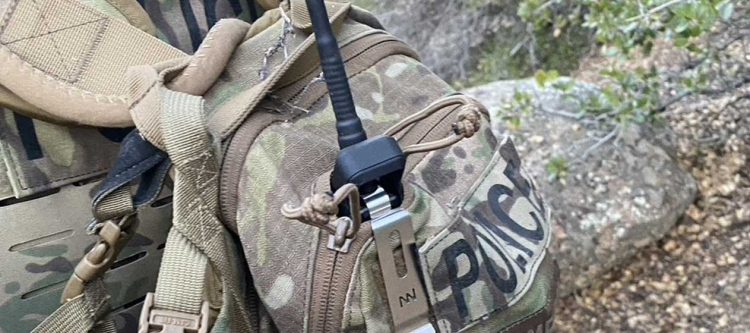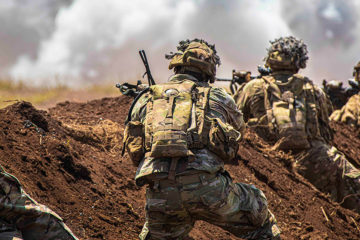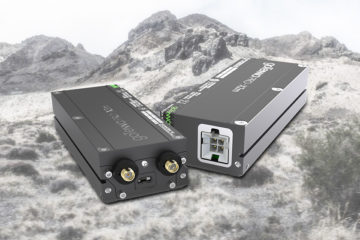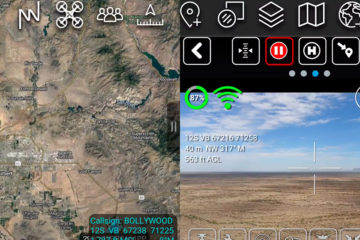Creating an integrated aerial ISR and comms solution for all environments

In our last article on The Last Mile, we featured the first part of a discussion with Callie Groth, the CEO of BlackBar Engineering, a small engineering firm doing big things for the U.S. Department of Defense (DoD). BlackBar’s mission involves using innovative, modern approaches to product design, development, prototyping, and manufacturing to quickly fill operational gaps for military missions.
We also talked extensively about the Storm autonomous unmanned aerial system (UAS), and how the firm’s approach to the solution’s design and manufacturing is making it a better, more flexible, and more adaptable solution for its military partners.
In the second half of our discussion with Callie, we take a deeper dive into some of the more interesting attributes of the Storm – including its ability to operate in a fully-autonomous fashion. We also explore how the integration of mobile mesh networking into the Storm could turn an ISR solution into an integrated intelligence and communications solution for military missions in even the most remote and austere environments.
 The Last Mile (TLM): BlackBar claims that the Storm is “fully autonomous.” What does that mean?
The Last Mile (TLM): BlackBar claims that the Storm is “fully autonomous.” What does that mean?
Callie Groth: When you have a fully autonomous vehicle, in standard terms, it means that the vehicle can perform a task or mission without any human involvement. While the Storm does require a human to launch the aircraft, it is fully autonomous in the execution of its mission. That means, once this aircraft is launched, it will conduct the mission with no additional input or direction from the operator.
All of [the Storm’s] waypoints can be pre-programmed. The entire mission can be pre-programmed. So, the minute that this aircraft leaves the operator’s hands, it knows exactly where to climb out to, it knows exactly which waypoints it’s going to meet, and it will follow whatever perimeter or whatever distance it was programmed to travel. Then, at a certain battery level or upon mission completion, the aircraft has been pre-programmed to come back and conduct an auto-land at a designated point. When the mission is complete, at no point during that mission was an operator required to conduct maneuverability, make flight changes, or perform mission planning.
However, what makes this aircraft ideal is that – at any point during that mission – in the event that an operator needs to change mission parameters or take control of the aircraft, they can immediately intercept the mission and make those changes, as needed. They can then send the aircraft back into its mission and conduct its auto-land operation as well. So, while the Storm is fully autonomous if the mission dictates, it can perform in a semi-autonomous fashion – meaning the aircraft will fly, maintain its altitude, maintain its speed, and maintain anything else that the operator input into it while still taking manual controls from the operator.
TLM: What situation would determine if an operator should deploy the Storm fully autonomously or not? In what use cases would one want the Storm to operate autonomously, and in what use cases would an operator want to take control?
Callie Groth: Much like we discussed, the military doesn’t always know what the environment or operating conditions will be like during its missions. For basic missions where all of the parameters are known, fully autonomous operation would be ideal.
For example, think about a standard, perimeter-based security mission, or any other type of standard intelligence, surveillance, and reconnaissance (ISR) mission. The operator knows that the aircraft needs to follow a specific perimeter that doesn’t change. Or the operator knows exactly what point of interest or coordinates they want the aircraft to explore. For the most part, there are not going to be circumstantial changes during standard surveillance operations. That can all be pre-programmed and be a fully autonomous mission.
“Open systems and architectures allow the military to be more expedient both programmatically and operationally. It’s a threat to the safety of operators and the mission when they’re in an environment and trying to make something work that’s not working as it should.” – Callie Groth
Semi-autonomous operation is required in operations with unknown or unclear parameters or circumstances. Scenarios such as quick, ad-hoc surveillance operations, or missions like battle damage assessments, are missions where operators might want the Storm to operate in a semi-autonomous fashion. Semi-autonomous flight is necessary for any mission or circumstance where the environment is constantly changing.
Ultimately, if the operator knows what they’re getting into, fully autonomous operation is ideal. If they don’t know what awaits them during the mission, semi-autonomous operation may work best.
TLM: Could you describe how a fully autonomous flight would be planned and executed?
Callie Groth: That’s a great question. Everything about the aircraft is programmable directly from the ground control station. The aircraft does not require any other equipment – such as a computer – to program the mission parameters.
The ground control station has maps with digital terrain overlay, which allows the operator to see elevation, terrain changes, and latitude and longitude coordinates. The operator can then use a stylus or finger on the touchscreen map to establish a flight path for the Storm.
For example, from that ground control station, the operator can dictate that they want the Storm to fly a half-mile perimeter around a particular area. This would enable them to see everything that’s on the ground in that area. Or they can program it to fly 10 kilometers in one direction along a major road or highway and then return. In those instances, the aircraft would fly along that pre-programmed perimeter, or fly out for 10 kilometers along a highway, before returning home and landing automatically. All of that is programmable directly from that ground control station.
TLM: Is BlackBar currently working to add any additional capability or functionality to the controller? What new capabilities is the company planning to add in the near term?
Callie Groth: We’re always looking for opportunities to improve our solution and add new capabilities for end users. That also means that we’re constantly looking for new companies that we can partner with, and new open architecture components and parts that we can integrate into the Storm to make it a more capable solution.
For example, a company called Tomahawk Robotics has created a common controller with integrated artificial intelligence (AI). This common controller not only allows the operator to program the aircraft, but to also conduct basic threat detection. We are currently in the very early stages of working with them to integrate their common controller into the Storm so that our users can benefit from those AI tools and capabilities.
TLM: The Storm is a modular solution that was built with an open system or open architecture approach. Why is this important for the military today? What do open systems enable the military to do today and into the future?
Callie Groth: Open systems and architectures allow the military to be more expedient both programmatically and operationally. It’s a threat to the safety of operators and the mission when they’re in an environment and trying to make something work that’s not working as it should. Open systems make it easier to get that solution working and to troubleshoot problems. Often, the end user does not have the time or ability to call an OEM and troubleshoot the problem. It’s prohibitive to the operation.
More often than not, the OEM is not there. They’re not the ones operating the equipment in theater. When what was originally provided doesn’t quite work, and the military has to change it, or they have to manipulate it in a way to try to improve efficiency, it’s important to have open systems with the ability to make those changes.
“If we successfully integrate the goTenna ProX2 with the Storm, we’re creating a small tactical aircraft that is conducting real-time surveillance, and functioning as a relay or repeater, relaying communications to different people in different operating environments.” – Callie Groth
Then there’s the issue of cost efficiency and cost-effectiveness. When any government agency or military organization is dependent on one vendor, it can be very financially lucrative for that vendor. They are in control of the market and that specific product channel. It does not allow for effective cost management. When the military becomes dependent on one vendor, that company controls the cost.
The primary reason for wanting open architecture across the military is operational efficiency. But, at the end of the day, the military doesn’t want to be held hostage by a single vendor that provides a product or service that fits their operational needs.
TLM: How is the Storm built with open standards in mind?
Callie Groth: BlackBar is not in the business of designing and developing autonomous flight controllers or autonomous flight software. Wherever possible, we are using commercial-off-the-shelf (COTS) components. That means all of the information that goes into the programming, the modification, the firmware updates, and the software updates for those components is all open source.
Therefore, since we’re using COTS components, if we have a customer that needs to quickly integrate a new flight controller, they can buy that flight controller directly from the vendor, they can integrate it themselves, and they can conduct all of the requisite firmware updates. They are not reliant on BlackBar to provide the flight controller, conduct the integration, and install the firmware updates.
That being said, we also understand that there can be reliability and security concerns with some open source software and hardware solutions on the market. Because these solutions are open source, and because they are designed and supported by an open community, there can be bugs and issues because there is no direct control over the software development and modifications.
This is why we rely on exquisite, proprietary solutions from trusted partners for the most flight-critical and mission-critical systems on our aircraft. For example, partnering with a company like Tomahawk Robotics would give BlackBar access to a ground controller solution that is not an open source solution, but is trusted, tested, and verified to work when the mission requires it.
TLM: Could mobile mesh networking solutions integrate with the Storm? How would that work and what benefits would the integration of mobile mesh deliver for the end user?
Callie Groth: Absolutely. First off, the data link that is currently integrated into the Storm is already mesh network capable and can connect to a variety of different nodes, or data links, at various locations. But by integrating a solution like the goTenna ProX2, we can give users the ability to create an entire communication network in practically any geographic location.
With a goTenna ProX2 integrated into the Storm, the operator now has the ability to cast a very wide network – a bubble of connectivity – over the entire region in which the Storm is operating. This is why we’re working to partner with goTenna and integrate the goTenna ProX2 into the Storm, so that users not only have a very lightweight, small tactical aircraft that can conduct full ISR capability, they’re getting a real-time feed on the ground, and creating an ad-hoc communications network that provides basic communications and situational awareness capabilities in even the most remote, geographically-isolated places on the planet.
“We’re always looking for opportunities to improve our solution and add new capabilities for end users. That also means that we’re constantly looking for…new open architecture components and parts that we can integrate into the Storm to make it a more capable solution.” – Callie Groth
What makes that very interesting – and a huge value for the operator – is its ability to create a complete, self-sufficient operational unit. Typically, when operators are flying an ISR aircraft, one or two different feeds are established. One operator is getting a real-time feed that they’re trying to transmit back to a joint operating base or a forward operating base, where it will be analyzed for actionable intelligence.
If we successfully integrate the goTenna ProX2 with the Storm, we’re creating a small tactical aircraft that is conducting real-time surveillance, and functioning as a relay or repeater, relaying communications to different people in different operating environments.
If we are able to leverage the goTenna ProX2 to establish a mobile mesh network, we’re creating a better infrastructure for communications and immediate real-time messaging and communication relay. We’re enabling off-grid communications in terrains and environments that are normally inaccessible with communications – rugged mountainous areas that typically struggle with line-of-sight communications.
If we are able to do that successfully, we can provide a twofold capability – real-time situational awareness, as well as real-time communication and decision-making. That is not currently possible in a one-system platform.
To learn more about BlackBar Engineering and its Storm UAS solution, click HERE.
Disclaimer: Please note, for all aerial assets, be sure to follow any applicable government regulations and restrictions during your deployment.









No Comment